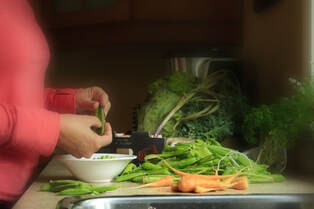 Preparing snacks. (Image, Deborah Carr)
Preparing snacks. (Image, Deborah Carr) As summer winds down, parents must once again start to think about returning to the fall routine – including packing school lunches, a task that many dread. It always seems to be a balancing act between creating lunches that are healthy and lunches that kids will actually eat, especially when they are not under a parent’s watchful eye.
First, remember that healthy lunches don’t have to be boring. You don’t need to reinvent the wheel, just use classic ideas with twists. A little imagination will go a long way! Instead of a traditional sandwich, try sandwich kebabs, switch up sliced sandwich bread for pita bread or a wrap cut into pinwheels, or use a cookie cutter to cut a sandwich into a fun shape. Sometimes a small change now and then is enough to keep children interested in their lunch.
Getting yourself and your family organized is also key to creating school lunches with staying power. Meal preparation at the beginning of the week can help make packing lunches quick and simple. For example, ‘batch cook’ foods like eggs, pasta, rice and proteins so they are in your fridge and ready to use whenever you make lunches. Or, when you are cooking supper, prepare extra to have for the next day’s lunches. Leftovers can often be reinvented into wraps or salads, or try some of the other options outlined below. These lunch ideas can work for all ages!
Pasta salads - Mix together leftover chicken, high-fibre penne pasta, veggies such as spinach, cucumber and peppers, cubed cheese and a vinaigrette. Switch up the ingredient combinations and dressings for different flavours, like Italian or Asian.
Picnic - Throw together favourite finger foods for a quick snack-like lunch! Keep it balanced by choosing one fruit, two veggies, one grain and one protein option, for example: grapes, pita bread triangles, and veggie sticks with hummus, cheese, tuna or a hard-boiled egg. You can even toast the pita to make crunchy pita chips.
Grain power bowls - Start with a base of the grain of your choice, like rice or quinoa, and top with vegetables, protein, and extras like cheese, avocado, or salsa. Roasted chickpeas, lentils or chicken can provide variety for the protein portion of the bowl.
Go small - Many kids, especially younger ones, find small food more appealing. Try cutting sandwiches into bite-size pieces or serving small crackers and mini-sized vegetables, such as matchstick carrots, snap peas or cucumber circles. Mini cucumbers are perfect for dipping, with no prep required! (Look for them in the produce department alongside the cherry tomatoes.) Include a small container of a healthy dip – the new plant-based cashew dips are a great choice for kids with lactose intolerance or who want a vegetarian option (check your kids’ school nut policy before sending in their lunch). Bright pink hummus made with beets, or green “monster” dip like the edamame dip recipe below will also keep the lunchbox fun!
Mini pizzas - Use mini naan rounds, tomato sauce, shredded cheese and chicken; get kids to assemble their own healthy pizza lunch.
When packing lunches for your kids, involve them as much as possible in the lunch-making process. You’ll find they will be much more apt to eat it without complaint!
|
When making lunches, or any meal, keep in mind that the new Canada’s Food Guide suggests to balance your plate or lunch box - with:
|
Protein sources include meat, eggs, dairy products and plant-based proteins, such as tofu, beans, lentils, nuts and seeds. |
Ingredients:
- 2 cups PC Edamame, thawed
- 1 cup packed fresh parsley leaves
- ½ cup basil pesto
- ½ cup extra virgin olive oil
- ¼ cup fresh lemon juice
- 1/8 tsp salt
- 1/8 tsp freshly ground black pepper
- 1 tsp finely grated lemon rind
Directions:
Pulse together edamame, parsley, pesto, oil, lemon juice, salt, and pepper in food processor for one to two minutes, scraping down side of bowl once or twice, or until completely combined. Scrape into serving bowl. Mix in lemon rind. If desired, garnish with a drizzle of oil and a few basil leaves.
Dietitian’s Tip: Edamame is a plant-based source of protein that can easily be added to salads, soups, and salsas.
Makes 20 servings. Per serving: 100 calories, fat 9 g, sodium 80 mg, carbohydrate 3 g, fibre 1 g, protein 3 g. Low Sodium
Recipe source: pc.ca
 RSS Feed
RSS Feed